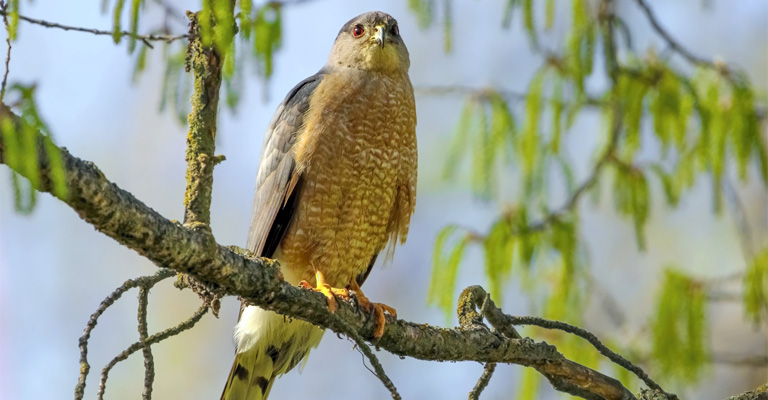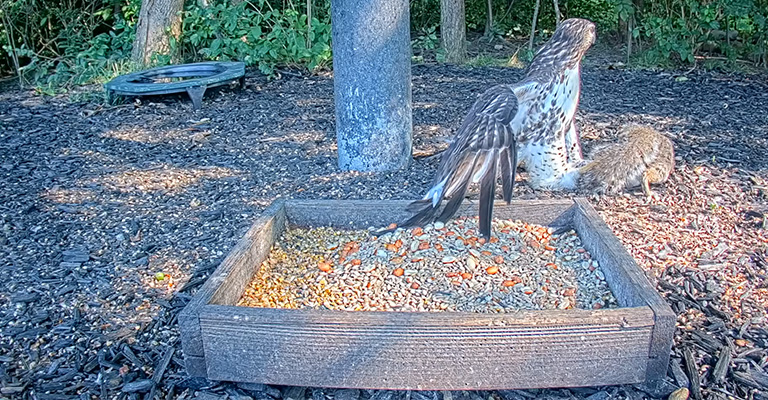Bird enthusiasts take great pleasure in attracting colorful and melodious avian visitors to their yards with the help of bird feeders. However, nature’s predators, such as hawks, may see these feeding stations as opportunities for an easy meal.
While hawks are majestic birds of prey deserving of respect, it’s essential to strike a balance between appreciating their presence and ensuring the safety of the smaller birds that frequent your feeders. In this guide, we will explore how you keep hawks away from bird feeders.
From understanding hawk behavior to implementing effective deterrents, you’ll gain valuable insights into coexisting harmoniously with these magnificent raptors while maintaining a haven for your feathered friends.
By following these tips, you can create a secure and inviting environment where both hawks and songbirds can thrive.

How Do You Keep Hawks Away from Bird Feeders?
Protecting your backyard birds from hawks requires a balanced approach that respects the natural order of things while ensuring the safety of your feathered friends.
Now, we will explore various strategies and techniques to help you deter hawks without causing harm to these majestic birds of prey.
Strategic Feeder Placement Near the Cover
Position your bird feeders near shrubs, trees, or other natural cover. This allows smaller birds to have quick escape routes if a hawk approaches. Hang feeders under eaves, awnings, or structures that limit a hawk’s swooping ability.
Hawks prefer open areas for hunting, so reducing visibility from above can deter them.
Use of Predator Decoys and Reflective Objects
Place owl decoys near your feeders. Hawks are known to avoid areas where they detect potential predators like owls. Move the decoys regularly to prevent hawks from recognizing them as stationary objects.
Hang reflective objects like shiny tape strips or old CDs around the feeding area. The glinting sunlight can startle hawks and make them think twice about approaching.
Timing of Feeding
Hawks are most active during the day. Consider limiting bird feeding to the early morning or late evening when hawks are less likely to hunt.
Plant shrubs and bushes near your feeders to provide shelter and hiding spots for smaller birds. Dense vegetation can make it difficult for hawks to target their prey.
Regular Monitoring
Keep an eye on your feeding area, and be ready to intervene if you see a hawk approaching. Your presence alone can deter them from attempting.
Install wire netting or grids around your feeders. This can create a barrier that hawks find challenging to navigate, reducing their chances of success.
Variety of Feeders
Use various feeder types, including tube feeders, hopper feeders, and platform feeders. This diversity can make it more challenging for hawks to target a specific type of feeder.
Birds in larger flocks tend to feel safer. By attracting more birds to your feeders, you can reduce the likelihood of an individual bird becoming a hawk’s target.
Provide Natural Cover
If possible, create a more extensive bird-friendly habitat by planting trees and evergreens. These taller structures can provide additional protection for smaller birds.
It’s important to note that hawks are protected by various state and federal laws in many regions. It is illegal to harm or harass them.
When implementing hawk deterrents, be sure to do so in a way that does not cause harm or distress to the hawks. The goal is to create a safer environment for all birds without endangering any species.
Observation and Adaptation
Every backyard and its avian visitors are unique, so it’s crucial to pay attention to the effectiveness of your deterrent strategies. Hawks can be persistent, and they may adapt to your efforts over time.
By observing their behavior and making adjustments as needed, you can strike a balance that ensures the safety of your feathered friends.
What Attracts Hawks to Bird Feeders?

Hawks are not typically attracted to bird feeders for food, as they are skilled hunters who prefer live prey. However, certain factors around bird feeders can indirectly attract hawks.
Here are some considerations on what might attract hawks to bird feeders and how to minimize such attraction:
Abundance of Smaller Birds
Bird feeders attract a variety of smaller birds that come to feed on seeds and other offerings. The presence of these smaller birds can be appealing to hawks, as they may see them as potential prey. Hawks often hunt near bird feeders in the hopes of catching an easy meal.
To reduce the risk of attracting hawks, consider placing your bird feeders in areas with natural cover, such as trees or shrubs, where smaller birds can quickly take refuge if a hawk appears. Providing escape routes and cover will help protect the smaller birds.
Hunting Opportunity
Hawks are opportunistic predators, and they may monitor bird feeders for potential hunting opportunities. They are more likely to visit feeders in areas with a high concentration of small birds. When a hawk detects an opportunity, it may swoop down to catch a bird.
Make it more difficult for hawks to ambush birds at your feeders by placing feeders in open areas where hawks are less likely to surprise their prey. You can also use reflective objects or wind chimes near the feeders to alert smaller birds to the presence of a hawk.
Feeder Design
Certain feeder designs can inadvertently make it easier for hawks to catch birds. Platform feeders or feeders without protective features can allow hawks to perch nearby and ambush birds as they come to feed.
Opt for feeder designs that offer protection for smaller birds. Tube feeders with perches and small feeding ports can deter hawks from perching and hunting. Additionally, hanging feeders with baffles or cages can make it more challenging for hawks to access the birds.
Time of Day
Hawks are diurnal birds of prey, meaning they are most active during daylight hours. They are more likely to visit bird feeders during the day when smaller birds are active and feeding.
If you want to minimize hawk visits, consider taking down or covering your feeders during the peak hunting times for hawks. This can discourage their presence when smaller birds are feeding.
Variety of Bird Species
A diverse bird species at your feeders can attract hawks, as they may be drawn to the variety of potential prey. Hawks may view the feeders as a buffet of options.
You can reduce the likelihood of attracting hawks by placing feeders specifically designed for different types of birds at various locations in your yard. This can help disperse the feeding activity and reduce the concentration of potential prey in one area.
Avoid Overfeeding
Overfilling your bird feeders can lead to an excess of seeds and birds congregating in one spot. This concentration of prey can make it more tempting for hawks to visit the area.
Keep your bird feeders well-maintained and only provide enough food for the birds to consume within a day or two. This will help prevent an excessive number of birds from gathering in one place.
Natural Habitat
Bird feeders located in areas with ample natural habitat, such as trees, shrubs, and vegetation, can be more attractive to hawks. The surrounding vegetation provides cover for hawks to hide and observe their potential prey.
If you’re concerned about hawks visiting your feeders, consider placing feeders away from dense cover and near more open spaces. This can make it less appealing for hawks to hunt in the area.
While hawks are not attracted to bird feeders for the food provided, they may be drawn to the presence of smaller birds that frequent feeders.
To minimize the risk of hawks hunting at your feeders, you can strategically design your feeding setup, provide natural cover for smaller birds, and adjust the timing of your feeding activities.
Balancing the needs of both the birds at your feeders and the local wildlife, including hawks, can help create a harmonious backyard habitat.
FAQs
How do I keep hawks away from my bird feeders?
To deter hawks from your bird feeders, you can try placing the feeders in more open areas with less cover for hawks to hide. Additionally, consider using hanging feeders with baffles or cages to make it more difficult for hawks to access the birds.
Monitoring the feeders and temporarily removing them during peak hawk activity times can also help.
Do scare tactics work to keep hawks away from bird feeders?
Scare tactics like reflective objects, wind chimes, or motion-activated devices can be effective in deterring hawks temporarily. These tactics disrupt the hunting process and make hawks less likely to approach your feeders.
However, they may become less effective over time as hawks become accustomed to them.
Can I use decoys to scare hawks away from my bird feeders?
Some people use decoys like owls or hawk statues to mimic predators and deter hawks. While this may work temporarily, it’s important to periodically move the decoys to prevent hawks from recognizing them as non-threats. Keep in mind that the effectiveness of decoys can vary.
Are there specific feeder designs that are hawk-resistant?
Feeder designs with protective features like small feeding ports, perches, and cages can deter hawks from perching and hunting at your feeders. Tube feeders with these features are a good option, as they make it more challenging for hawks to access the birds.
What should I do if I see a hawk near my bird feeders?
If you spot a hawk near your bird feeders, it’s essential to allow it to pursue its natural hunting behavior. Avoid disturbing the hawk or attempting to scare it away aggressively.
Instead, provide natural cover for the smaller birds, such as nearby trees or shrubs, where they can take refuge if a hawk approaches.
Conclusion
While hawks are captivating and essential members of the ecosystem, it’s possible to find a balance between their presence and the safety of the smaller birds that frequent your bird feeders.
By taking proactive steps to deter hawks from your feeding area, you can continue to enjoy the delightful sights and sounds of your avian visitors without compromising their well-being.
Remember, the goal is not to harm or eliminate hawks but to create a safe space for all birds to coexist peacefully. Implementing strategies like adding cover, using reflective objects, or adjusting feeder placement can go a long way in reducing the risk of hawk predation.
As you embark on this journey to protect your feathered friends, always stay informed about local laws and regulations regarding the protection of raptors.
By respecting both the predator and the prey, you can foster a harmonious and thriving backyard habitat that brings joy to bird enthusiasts while preserving the natural balance of the avian world.